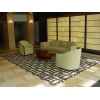|
 If you flip
through the social life section in any glossy magazine, you'll see that any it-girl
is struggling to win the prefix «designer». We can make jokes about how «you
decorate your father's office and now you're interior designer!» or follow in
the footsteps of the famous designers, and - who knows - achieve outstanding
results in the domain of interior decoration. If you flip
through the social life section in any glossy magazine, you'll see that any it-girl
is struggling to win the prefix «designer». We can make jokes about how «you
decorate your father's office and now you're interior designer!» or follow in
the footsteps of the famous designers, and - who knows - achieve outstanding
results in the domain of interior decoration.
However, a full-time
or episodic work as a decorator or designer requires not only the flair for
decoration and a sense of style, but also a substantial training and specific
skills. From their early days, people had a passion for decoration and throughout
its long history have accumulated many artistic traditions, which serve as a basis
for a distinct and balanced style of interior decoration.
Current
trends of eclecticism and mix-and-match in clothing, cooking, and interior decoration
give an excuse for being not creative as you can mix seemingly irreconcilable
things and it will work out perfectly nevertheless. However, this assumption is
far from the truth, as to break the rules one has to know them.
Here are some
basic interior design styles:
Ethnic (country)
design style includes traditional Egyptian, Arabic, Thai, African, Japanese or
Chinese styles of interior decoration, as well as American, English or French
country style. This style is distinguished by bright colors and a plenty of
traditional design elements. Ethnic effect is achieved by using numerous ethnic
details, i.e. various objects of modern craft that imitate the original antics.
However, no one would mind using an original Qing vase in recreating Chinese
interior design style.
The
essential elements of African design style are animal skins (real or fake),
plants, rugs, and rattan and bamboo furniture. The highlights of traditional Japanese
design style are tatami mats, brightly painted screens and room dividers, small
lacquered tables and miniature cabinets. Egyptian design style is associated
with warm earthy yellow colors with touches of azure blue, gold and black, friezes
and caps of faux columns, with simulated lotus or papyrus flowers, gold and
ivory decor. Egyptian interior design may use iconic Egyptian symbols, such as
Queen Nefertiti's head, a pyramid or a cat. The ceiling can be painted in dark
blue and decorated with golden stars as a reference to the temple of Ra, the
ancient Egyptian deity of the Sun. If you are planning to redecorate your
apartment or your room in one of the ethnic design styles, you must learn about
the culture and history of the country you're interested in.
Colonial interior
design style can also be classified as ethnic, as this style exploits same recognizable
oriental details but in their European interpretation, with civilized,
comfortable, and forward approach. The main condition: all furniture and
utensils must be authentic and have their own history. Choose warm earthy tones
for walls, floors and ceilings, as to some extent, they will form the setting
for colonial furniture items, such as exotic panels, wall plates, capes,
blankets, and fans. Do not try to embrace all the design options by putting
massive cabinets and chairs in a small room: light and space should be balanced!
Colonial interior design style is a style of a sophisticated, educated people
who conquer new territories with respect and interest in their culture.
High-tech style.
As a rule, high-tech design style is commonly combined with the least
decorative variety of the Japanese interior style. First, this happens due to a
completely understandable association of high tech with Japan, and second, numerous
home appliances, which play an important role in this interior style, are best
combined with spacious uncluttered room, full of light and air. Nevertheless,
high-tech originated in France during the construction of the Pompidou Center.
Basic features of high-tech: neutral colors, scarce furniture of minimalist
design, metal surfaces, futuristic décor details. When decorating your home in
high-tech style, steer away from too much metal and sterility to avoid creating
the hospital ward space. Try to lighten the room up with splashes of matching
color, as clashing colors can be distracting. The principal advantage of high-tech
style is its integrity and elegant beauty. This style is duly recognized as the
most appropriate for limited spaces.
|